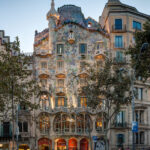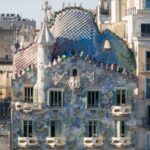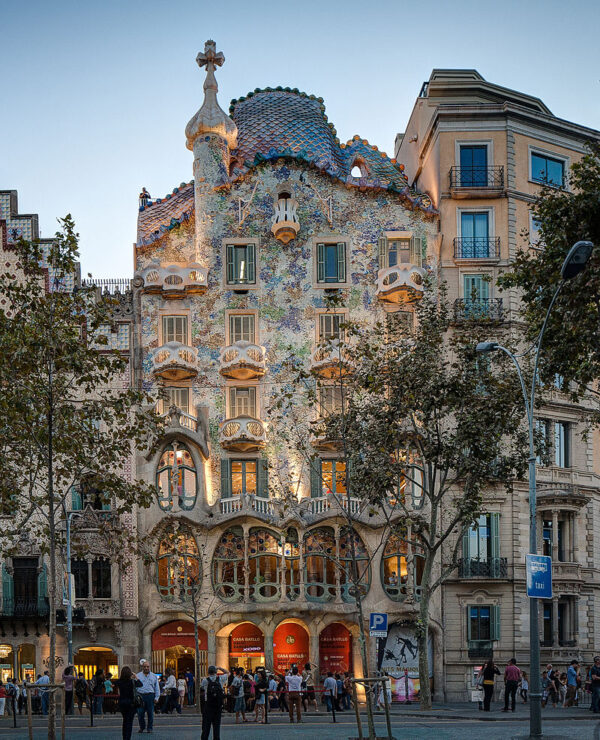
- The Architectural Brilliance of Gaudí in the Batlló Residence
- Exploring the Symbolism in Casa Batlló's Design Elements
- A Detailed Look at Gaudí's Use of Color in Casa Batlló
- The Historical Significance of the Batlló Family Residence
- How Casa Batlló Reflects Gaudí's Innovative Approach to Architecture
- Understanding the Cultural Impact of Gaudí's Work on Modern Design
Antoni Gaudí, a pioneering architect of the late 19th and early 20th centuries, transformed the landscape of Barcelona with his innovative designs. Among his most celebrated works is **Gaudí's Unique Residence for Batlló Family**, a stunning example of modernist architecture that captivates visitors with its organic forms and vibrant colors.
This extraordinary residence, located on Passeig de Gràcia, reflects Gaudí's deep connection to nature and his visionary approach to design. Built for the Batlló family, the structure showcases a harmonious blend of functionality and artistry, making it a true masterpiece of architectural heritage.
The Architectural Brilliance of Gaudí in the Batlló Residence
Gaudí's architectural brilliance in the Batlló Residence is evident through his innovative use of natural light and organic shapes. The façade, adorned with colorful mosaics and flowing lines, mimics the undulating forms of marine life, creating a mesmerizing visual experience. Visitors often find themselves enchanted by the way light filters through the stained glass windows, casting vibrant patterns throughout the interior.
Another striking feature of the residence is its emphasis on sustainability and harmony with the environment. Gaudí incorporated natural ventilation systems and used materials sourced from the surrounding landscape. Key elements contributing to this philosophy include:
- Curved Walls: These designs reduce the need for artificial lighting.
- Natural Materials: Stone and wood are used to enhance thermal insulation.
- Green Spaces: The integration of plants reflects Gaudí's respect for nature.
The interior spaces of the Batlló Residence are equally remarkable, showcasing Gaudí's masterful attention to detail. Architectural elements such as the whimsical staircases and flowing woodwork create a sense of fluidity, resembling the movement of water. Each room tells a unique story, with design features that invite occupants to experience a seamless blend of art and functionality.
In terms of structural innovation, the Batlló Residence is a pioneer of modernist architecture. The use of reinforced materials and advanced construction techniques allowed Gaudí to challenge conventional building norms. This residence not only serves as a stunning example of his artistic vision but also stands as a testament to the evolution of architectural practices in the early 20th century.
Exploring the Symbolism in Casa Batlló's Design Elements
Exploring the symbolism in Casa Batlló's design elements reveals Gaudí's profound connection to nature and the human experience. The façade is often likened to a dragon's back, representing strength and protection. This imaginative imagery is further enhanced by the use of vibrant colors and organic shapes, which evoke feelings of life and movement, inviting visitors to experience the essence of nature through architecture.
One of the most striking design elements is the use of mosaic tiles, known as trencadís, which symbolize the beauty of diversity in nature. This technique, utilizing broken ceramic pieces, not only enhances aesthetics but also serves to remind viewers of the impermanence and transformation found in the natural world. The interplay of light on these surfaces creates an ever-changing visual experience, reflecting the dynamic essence of life.
The interior of Casa Batlló is equally rich in symbolism. Architectural features such as the bone-like columns and wave-shaped ceilings evoke the forms found in marine environments, illustrating Gaudí's fascination with the sea. This emphasis on fluidity and organic shapes connects occupants to the rhythm of nature, encouraging a sense of harmony and tranquility within the living spaces.
Additionally, the clever use of light and space throughout Casa Batlló symbolizes the idea of enlightenment and discovery. The strategically placed windows and skylights allow natural light to penetrate deep into the structure, creating a warm and inviting atmosphere. This illumination not only enhances the beauty of the space but also serves as a metaphor for knowledge and creativity, inviting all who enter to explore the depths of Gaudí's artistic vision.
A Detailed Look at Gaudí's Use of Color in Casa Batlló
Antoni Gaudí's use of color in Casa Batlló is a defining feature that enhances the building’s organic aesthetic. The vibrant hues are not merely decorative but serve to emulate the natural world, reflecting light and shadow in ways that evoke ocean waves and the sky. This chromatic design approach invites visitors to experience a sensory connection to nature, making the residence feel alive and dynamic.
The façade of Casa Batlló is embellished with a stunning array of colors achieved through the innovative use of mosaic tiles, known as trencadís. This technique, which involves assembling broken ceramic pieces, results in a rich tapestry of shades that shift with the sunlight. The colors chosen by Gaudí are thought to symbolize:
- Life: Bright colors evoke vitality and movement.
- Nature: Greens and blues reflect the aquatic world.
- Emotion: Warm tones express warmth and hospitality.
Inside, Gaudí’s color palette continues to enchant, with walls and ceilings painted in soft, inviting tones that harmonize with the natural light. The use of colored glass in windows filters this light, casting beautiful patterns that change throughout the day. This careful orchestration of color and light creates an atmosphere that feels both tranquil and invigorating, encouraging occupants to engage with their environment.
Moreover, the strategic placement of colors throughout the residence serves as a guide for movement and interaction within the space. For example, warmer shades are used in areas meant for socializing, while cooler tones can be found in more private spaces. This thoughtful approach to color not only enhances aesthetic appeal but also reinforces the functionality of each room, illustrating Gaudí's genius in marrying art with purpose.
The Historical Significance of the Batlló Family Residence
The historical significance of the Batlló family residence lies not only in its stunning architecture but also in its role within the broader context of Catalan modernism. Constructed between 1904 and 1906, this masterpiece embodies the transition from traditional construction to innovative design, showcasing Antoni Gaudí's unique interpretation of architectural identity. As a symbol of the cultural and social evolution in Barcelona, it reflects the desires of a wealthy family seeking both elegance and modernity.
Furthermore, the residence serves as a testament to the Batlló family's influence in the textile industry during the early 20th century. Their status allowed them to commission Gaudí, whose reputation was burgeoning at the time. This partnership not only showcases the nexus between **art and commerce** but also elevates the Batlló residence to a landmark that encapsulates the aspirations of a progressive society eager to embrace new artistic movements.
In addition to its architectural and cultural importance, the Batlló residence is notable for its innovative use of materials and techniques that were ahead of its time. Gaudí's pioneering approach included the integration of local materials and sustainable practices, reflecting a growing awareness of environmental considerations. This foresight makes the residence a precursor to contemporary sustainable architecture, highlighting the enduring relevance of Gaudí's work in today's discussions surrounding eco-friendly design.
Lastly, the Batlló residence remains a vital part of Barcelona's urban fabric, attracting millions of visitors each year. It stands not only as a physical structure but also as a symbol of the city's rich artistic heritage. Its inclusion in UNESCO's World Heritage List further cements its status as a critical site for understanding the evolution of architectural styles and the celebration of human creativity in the modern age.
How Casa Batlló Reflects Gaudí's Innovative Approach to Architecture
Casa Batlló embodies Antoni Gaudí's innovative approach to architecture through its unique blend of form and function. The fluid shapes and organic motifs present in the structure are designed to mimic natural forms, reinforcing the idea that architecture should harmonize with the environment. This vision allows the building to not only serve as a residence but also as an artistic expression, inviting occupants and visitors to engage with the space on a sensory level.
Another hallmark of Gaudí's innovation is the use of light and shadow within Casa Batlló. The strategic placement of windows and the thoughtful design of open spaces create an interplay of natural light that enhances the aesthetic experience. This dynamic quality of illumination not only brightens the interiors but also fosters a connection to the outdoors, effectively blurring the lines between the inside and outside worlds.
Gaudí's dedication to sustainability is also evident in Casa Batlló, where he employed materials that were both locally sourced and environmentally friendly. For instance, the use of natural ventilation systems and energy-efficient design elements exemplifies his foresight in creating a building that respects its ecological context. This commitment to sustainability positions Casa Batlló as a precursor to modern eco-friendly architectural practices.
Finally, the integration of symbolic elements throughout the residence reflects Gaudí's unique artistic vision. From the dragon-like façade to the marine-inspired details within, each feature tells a story that connects back to nature and humanity. This multi-layered symbolism invites viewers to interpret the building in various ways, further highlighting Gaudí's innovative ability to merge art with architecture in a way that resonates with diverse audiences.
Understanding the Cultural Impact of Gaudí's Work on Modern Design
Antoni Gaudí's architectural legacy has profoundly influenced modern design principles, blending functionality with artistic expression. His unique approach has inspired contemporary architects to embrace organic forms, emphasizing a connection to nature and sustainability. By challenging traditional aesthetics, Gaudí paved the way for a new understanding of how built environments can reflect human experiences and the natural world.
One significant aspect of Gaudí's impact is his use of color and light to create immersive spaces. Modern designers often draw from his innovative techniques, employing natural light to enhance the sensory experience of interiors. This approach encourages a dialogue between the architecture and its surroundings, fostering a deeper appreciation of the spaces we inhabit. Key elements influenced by Gaudí include:
- Dynamic forms: Inspired by natural shapes and movements.
- Color harmony: Using color to evoke emotions and enhance functionality.
- Natural materials: Prioritizing sustainability by integrating local resources.
Furthermore, Gaudí's emphasis on symbolism within architecture has resonated with modern designers, prompting them to incorporate meaningful narratives into their work. This trend encourages the exploration of cultural identity and personal stories through design, creating spaces that are not only visually captivating but also rich with significance. By intertwining art with everyday life, Gaudí's influence continues to shape contemporary architecture.
In summary, the cultural impact of Gaudí's work on modern design is evident in the ongoing exploration of sustainability, innovation, and sensory engagement. As architects and designers continue to draw inspiration from his pioneering methods, Gaudí's legacy remains a vital force in shaping the future of architectural practices worldwide.
 Why Casa Batlló is Significant
Why Casa Batlló is Significant Casa Batlló: A Famous Landmark
Casa Batlló: A Famous Landmark The Majestic Beauty of Sagrada Familia in Barcelona: A Captivating Pictorial Journey
The Majestic Beauty of Sagrada Familia in Barcelona: A Captivating Pictorial Journey Reasons for Building Casa Batllo
Reasons for Building Casa BatlloIf you want to know other articles similar to Gaudí's Unique Residence for Batlló Family you can visit the category WHERE YOU CAN GO.
Deja una respuesta










Read more!